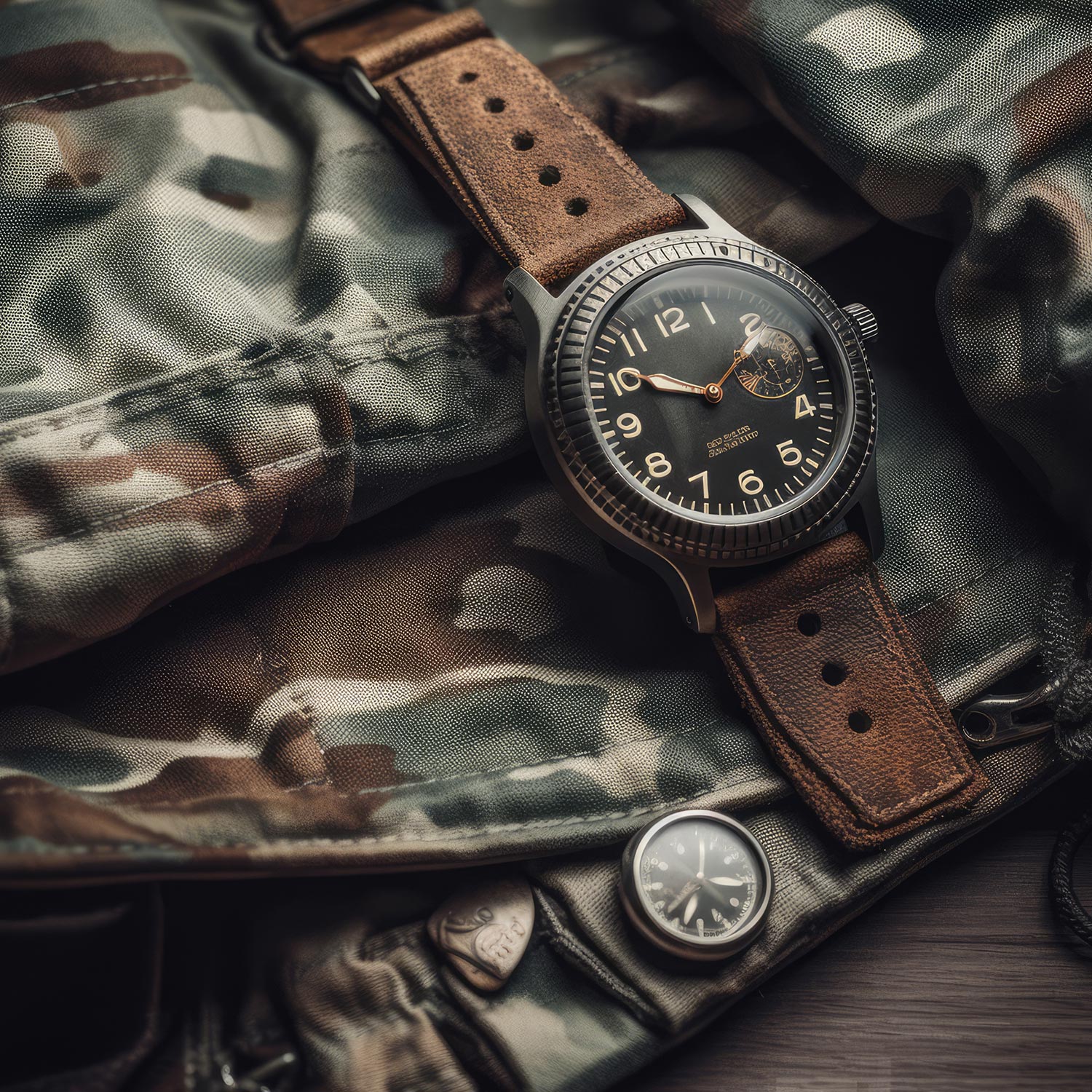General
Defining a military watch can be challenging. Some manufacturers, like G-Shock, do not design watches exclusively for military use, yet their robustness makes them popular among military personnel. Others, such as Marathon, focus specifically on military and Search and Rescue (SAR) watches. MWC supplies not only the military but also police forces, anti-terrorist units, airlines, mining companies, specialist marine security units, shipping and salvage organizations, and various government agencies, all of which require watches that meet military specifications.
The following recommendations are generally accepted:
- 50 meters (165 feet/5ATM): Suitable for swimming in shallow water, such as pools and rivers.
- 100 meters (330 feet/10ATM): Suitable for swimming and snorkeling.
- 150 meters (500 feet/15ATM): Suitable for snorkeling.
- 200 meters (660 feet/20ATM): Suitable for sports diving.
- 300 meters (1000 feet/30ATM): Suitable for professional diving and military applications.
- 500 meters (1500 feet/50ATM): Suitable for professional diving and military applications, often featuring a helium valve.
- Over 1000 meters (3389 feet/100ATM): Suitable for deep professional diving with mixed gases at extreme depths and challenging military applications.
Note: We recommend swimming or diving with watches rated at least 100 meters with a screw-down crown. Military watches rated at 50m/150ft, like the MWC G10 with a battery hatch, are generally fine. However, be cautious with 30m or 99ft rated models with acrylic crystals, as they may have lower water resistance. We offer A-11, A-17, and GG-W-113 models with 100m variants and glass crystals that meet modern standards while maintaining a retro appearance.
Avoid wearing even highly rated water-resistant watches in hot showers, saunas, or baths. Extreme heat can cause metal parts to expand differently than rubber gaskets, potentially allowing water to penetrate the watch. Alkaline substances like soap and shampoo can also rot the seals. Sudden temperature changes can cause thermal shock, which may affect the watch's performance.
After swimming or diving in salt water, rinse the watch in fresh water immediately. Turn the rotating bezel several times while rinsing to prevent salt build-up and corrosion.
Some chemicals can corrode the gaskets and damage the watch. Heavily chlorinated water, chlorine bleach, bath foams, and hairsprays can damage the gaskets and the watch's finish.
Leather straps, although rare on military watches, can be water-resistant. However, they are generally easily damaged by frequent exposure to water and can start to smell. Consider metal bracelets, carbon fiber, Kevlar, rubber straps, or Nylon NATO straps, which are ideal for water use. We offer a variety of strap options on our website.
If your watch is mechanical, unscrew the crown if it has a screw-down crown, then wind it clockwise until you feel resistance. Avoid over-winding to prevent damage. For automatic watches, regular wear should keep them wound, but occasional manual winding can help if not worn regularly.
Automatic watches typically have a power reserve of around 41 hours. If not worn for a day, manual winding may be necessary to keep it running.
PVD (Physical Vapor Deposition) is a process that applies a thin, durable coating to a material. It involves heating the item in an inert atmosphere and spraying it with the coating material, creating a bonded layer that resists wear and corrosion.
Accuracy
Accuracy varies with the type of watch. Mechanical watches will tend to gain or lose a few seconds over time and are less accurate than quartz or hybrid models. A modern mechanical watch could vary between +/- 15 seconds a day at worst and +/- 2 or 3 seconds a day at best. Quartz watches, however, are more accurate, typically within +/- 2 seconds a day.
Most modern wristwatches are accurate enough for normal use. Some people prefer the traditional technology and craftsmanship of mechanical watches, despite their slight accuracy disadvantage compared to quartz watches.
Typically, yes. Quartz watches are generally more consistent in performance than mechanical watches. However, mechanical watches can sometimes stay closer to correct time over a long period due to variations that tend to cancel each other out.
Yes, magnetism can be a significant issue for mechanical watches and can affect both hand-wound and automatic watches, primarily impacting the hairspring.
Even though many modern movements use Nivarox hairsprings, which are designed to resist oxidation and reduce magnetic interference, they still contain iron and nickel, making them susceptible to magnetic fields.
At MWC, we use Seiko and Sellita movements, known for their reliability, but strong magnetic fields can still influence the hairspring.
How Does Magnetism Affect a Watch? When exposed to a magnetic field, the coils of the hairspring can stick together, effectively shortening the spring and causing the watch to gain time.
In extreme cases, the hairspring may become so stuck that the watch stops running entirely.
✅ The good news: No permanent damage is usually done, and a watchmaker can quickly demagnetize the watch.
Demagnetization
Demagnetization
- We sell demagnetizers for €22 / £20 / $27, but a watchmaker can also demagnetize a watch in seconds.
- Since watches can re-magnetize, owning a demagnetizer can be useful.
Avoid Magnetic Exposure
Magnetism is everywhere. To protect your watch, try to avoid:
- 🛫 Airport security scanners
- 🏥 MRI machines
- 📱 Smartphones and tablets
- 👜 Handbag clasps (often magnetic)
- 🔊 Speakers, TVs, and other electronics
- 🚪 Security system door contacts
Many people don’t realize they've come into contact with a magnet until their watch starts running fast. For example: One of our customers found that every mechanical watch he wore became magnetized. The culprit? He worked with security tags, which contain strong magnets that unknowingly affected his watches.
A simple test:
- Place your watch near a compass.
- If the needle moves, your watch is magnetized.
- This is a 100% reliable way to diagnose the issue.
At MWC, we design our watches to withstand magnetic fields:
- An automatic watch is considered anti-magnetic if it can withstand 4,800 A/m (60 gauss) while maintaining accuracy within ±30 seconds per day.
- The NH35A movement, used in many of our automatic models, can typically resist 60-70 gauss (6,000-7,000 A/m) without significant deviations.
- Quartz watches are significantly less affected by magnetism, as they do not rely on a hairspring.
Final Thoughts
By understanding and minimizing exposure to magnetic fields, you can help maintain the accuracy and longevity of your timepiece.
Need a demagnetizer? Click here.
Alignment
Slight misalignment of the second hand is within manufacturing tolerances and does not indicate a defect. This is due to mechanical variations in the parts that move the hands.
The alignment of the caseback text is not a priority in watch manufacturing, as the precise tension needed for water resistance is more important. Misalignment does not indicate a flaw.
Strap Pins/Bars
MWC uses three types of pins: spring bars, screw pins, and fixed solid bars. Spring bars are versatile but can be dislodged; screw pins combine strength with versatility but need threadlock when reattached; fixed solid bars are robust but limit strap options to one-piece straps.
PRN/PNR Numbers
PRN stands for Prototyp Referenznummer (Prototype Reference Number), and PNR stands for Produktionsnummer Referenz (Production Number Reference). These numbers help identify the model's specifications, including the type of movement, luminous paint, lugs, and case material. They also aid in servicing and identifying variations in models.
Warranty Information & Repair and Service
The MWC International two-year warranty covers GTLS failure, movement failure, hands coming off, manufacturing defects, water ingress (under appropriate conditions), and more. It does not cover the battery, strap, damage due to misuse, or unauthorized repairs. For full details, refer to the warranty policy.
If you have customized the strap or affixed a different type of strap, you may want to remove it before sending the watch for repair, as the watch may be replaced with the standard strap for that model.
Contact us before sending any sentimental or engraved items for repair, as the watch could be replaced, and the original may not be returned.
For further questions or assistance, please feel free to contact us by phone or via email at admin@mwc.watch

